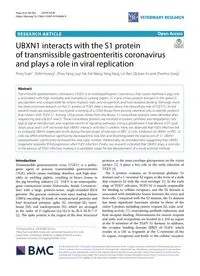
2019 UBXN1 interacts with the S1 protein of transmissible gastroenteritis coronavirus and plays a role in viral replicat PDF
Preview 2019 UBXN1 interacts with the S1 protein of transmissible gastroenteritis coronavirus and plays a role in viral replicat
Yuan et al. Vet Res (2019) 50:28 https://doi.org/10.1186/s13567-019-0648-9 RESEARCH ARTICLE UBXN1 interacts with the S1 protein of transmissible gastroenteritis coronavirus and plays a role in viral replication Peng Yuan†, Shilei Huang†, Zhou Yang, Luyi Xie, Kai Wang, Yang Yang, Lin Ran, Qiuhan Yu and Zhenhui Song* Abstract Transmissible gastroenteritis coronavirus (TGEV) is an enteropathogenic coronavirus that causes diarrhea in pigs and is associated with high morbidity and mortality in sucking piglets. S1 is one of two protein domains in the spike (S) glycoprotein and is responsible for enteric tropism, sialic acid recognition, and host receptor binding. Although there has been extensive research on the S1 protein of TGEV, little is known about the intracellular role of TGEV-S1. In the present study, we used yeast two-hybrid screening of a cDNA library from porcine intestinal cells to identify proteins that interact with TGEV-S1. Among 120 positive clones from the library, 12 intracellular proteins were identified after sequencing and a BLAST search. These intracellular proteins are involved in protein synthesis and degradation, bio- logical signal transduction, and negative control of signaling pathways. Using a glutathione-S-transferase (GST) pull- down assay and Co-IP, we found that UBXN1 interacts with the S1 protein. Here, we observed that TGEV infection led to increased UBXN1 expression levels during the late phase of infection in IPEC-J2 cells. Inhibition of UBXN1 in IPEC-J2 cells via siRNA interference significantly decreased the viral titer and downregulated the expression of S1. UBXN1 overexpression significantly increased the viral copy number. Additionally, we provided data suggesting that UBXN1 negatively regulates IFN-β expression after TGEV infection. Finally, our research indicated that UBXN1 plays a vital role in the process of TGEV infection, making it a candidate target for the development of a novel antiviral method. © The Author(s) 2019. This article is distributed under the terms of the Creative Commons Attribution 4.0 International License (http://creat iveco mmons .org/licen ses/by/4.0/), which permits unrestricted use, distribution, and reproduction in any medium, provided you give appropriate credit to the original author(s) and the source, provide a link to the Creative Commons license, and indicate if changes were made. The Creative Commons Public Domain Dedication waiver (http://creat iveco mmons .org/ publi cdoma in/zero/1.0/) applies to the data made available in this article, unless otherwise stated. Introduction Transmissible gastroenteritis virus (TGEV) is a patho- genic agent of porcine transmissible gastroenteritis (TGE), which causes vomiting, diarrhea, and high mor- tality in suckling piglets, resulting in heavy losses to the pig breeding industry [1]. TGEV is an enteropatho- genic coronavirus (order Nidovirales, family Coronaviri- dae) with a large, positive-sense, single-stranded RNA genome. The genome contains nine open reading frames (ORFs) encoding 16 kinds of nonstructural proteins and four structural proteins, spike (S), envelope (E), mem- brane (M), and nucleoprotein (N), which are arranged in the order of 5′-replicase-(1a/1b)-S-3a-3b-E-M-N-7-3′ [2]. The spike protein is the largest of the four structural proteins; as the main envelope glycoprotein on the virion surface [3], S plays a key role in the early infection of TGEV [4]. The S protein contains an N-terminal globular S1 domain and a C-terminal S2 region in the form of a stalk that connects S1 with the viral envelope [5]. In the early stage of TGEV infection, TGEV-S1 is mainly responsible for binding to cellular receptors, and the S2 domain is associated with membrane fusion between the virus and host cells. Compared with the S2 domain, the S1 domain has many significant functions similar to those of the entire S protein, including enteric tropism [6], sialic acid- binding activity [7], neutralizing antibody induction, and host receptor binding. Determinants for enteric tropism and sialic acid recognition are located in a 224 aa region at the N terminus of the TGEV S1 domain. In addition, the receptor binding domain (RBD) of TGEV, which resides in a 150 aa fragment at the C-terminus of the S1 region, recognizes and binds to the cellular receptor, Open Access *Correspondence:
